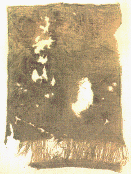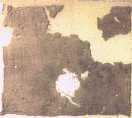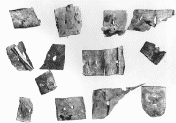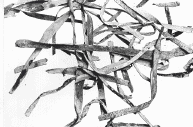
It is possible that all of the cloths found at Qumran are linked with the scrolls. Some of them were certainly scroll wrappers; the remains of one scroll was found wrapped in a small square of linen. Other cloths, found folded into pads, may have formed a packing for worn-out scrolls inside the scroll jars. Still other pieces--with corners twisted or bound with linen cord--may have been used as protective covers, tied over the jar tops.
The wrapped scrolls may have been concealed in the cave at a time of national panic or simply buried, as was a common practice, when they wore out. The condition of the cloths would coincide with either suggestion.

This cloth is cut along three sides, rolled and oversewn with a single thread; the fourth edge has a corded starting border in twining technique, followed by a woven strip and an open unwoven space. It was found folded into a pad and was probably used as packing material for discarded scrolls.
7Q, cloth 30
Length 35.5 cm (13 7/8 in.)
Width 24 cm (9 3/8 in.)
Counts: 14x14, 13x13, and in one place
16x14 threads per cm
Courtesy of the Israel Antiquities Authority (76)

The edges of this cloth are cut, rolled, and whipped on two opposite sides with single thread. On the other two sides, a double thread was used. Two corners are twisted, and the third has a piece of string knotting it, indicating that it was probably used as a cover for a scroll jar.
1Q, cloth 15 Length 29 cm (11 15/16 in.) Width 25 cm (9 3/4 in.) Counts: 17x13 threads per cm Courtesy of the Israel Antiquities Authority (75)

Thongs 
Tabs and thongs like these may have been used to bind and secure individual scrolls. The fastening method is thought to consist of a slotted tab folded over the edge of the scroll (see "Prayer for King Jonathan" scroll fragment) with a thong inserted through the tab's slot. The thong then could be tied around the scroll. Fasteners were generally made of leather and were prepared in different sizes. The leather thongs may have also been used in the making of phylacteries.
Tabs: length 1.7-2.7 cm (11/16 in.-1 1/16 in.)
width 1.4-3.3 cm (9/16 in.-1 5/16 in.)
Thongs: length 7-30 cm (2 3/4 in.-11 3/4 in.)
width 0.3-0.8 cm (1/8 in.-5/16 in.)
Courtesy of the Israel Antiquities Authority (90-100)
